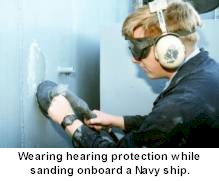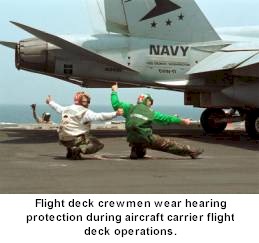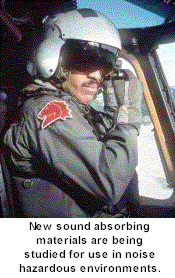|
Noise can impair communications, promote detection by the enemy, reduce
operator performance, and ultimately affect the efficiency and even the
survivability of ships, aircraft, and ground vehicles.
 Work-related
hearing loss is a critical workplace safety and health matter. Hearing loss
caused by prolonged exposure to high levels of noise can be permanent and
irreversible. The National Institute for Occupational Safety and Health (NIOSH)
and the occupational safety and health community identified hearing loss as
one of the 21 priority areas for research in the twenty first century. Work-related
hearing loss is a critical workplace safety and health matter. Hearing loss
caused by prolonged exposure to high levels of noise can be permanent and
irreversible. The National Institute for Occupational Safety and Health (NIOSH)
and the occupational safety and health community identified hearing loss as
one of the 21 priority areas for research in the twenty first century.
Due to the equipment they use and environments in which they work,
workers in certain industries experience high exposure to potentially
hazardous noise levels. These industries include agriculture, mining,
construction, manufacturing and utilities, transportation, and the military.
Noise is a fact of life onboard Navy ships. Machinery, aircraft, weapons,
ship's propulsion systems, and industrial operations contribute to a
potentially noise hazardous environment. In fact, noise-induced hearing loss
is the Fleet's number one occupational health expense. However, implementing
engineering controls may often considerably reduce the risk of noise
exposure.
 Noise
exposure can be described by its intensity, its frequency, and its duration.
Intensity of noise reflects the loudness of the sound, while the frequency
of the noise is reflected in how high or low pitched the noise is. The
duration or length of time an individual is exposed to a noise source is
important in predicting what effect it may have on that person's hearing
acuity. Exposure to very loud noise levels for a short period of time may
cause temporary hearing loss, but hearing is typically restored within 24
hours of non-exposure time. Long-term overexposures to hazardous noise
levels can permanently degrade hearing acuity. Noise
exposure can be described by its intensity, its frequency, and its duration.
Intensity of noise reflects the loudness of the sound, while the frequency
of the noise is reflected in how high or low pitched the noise is. The
duration or length of time an individual is exposed to a noise source is
important in predicting what effect it may have on that person's hearing
acuity. Exposure to very loud noise levels for a short period of time may
cause temporary hearing loss, but hearing is typically restored within 24
hours of non-exposure time. Long-term overexposures to hazardous noise
levels can permanently degrade hearing acuity.
Noise may also be described as continuous or impulse (impact). Hearing
loss through exposure to continuous loud noise is usually subtle; hearing
acuity deteriorates slowly over a long period of time, and may not be
obvious until there has been a substantial hearing loss. Impulse noise is
composed of sudden loud bursts of noise that occur for a very short
duration. It is possible to suffer permanent hearing loss from unprotected
exposure to a single loud impulse sound.
 Noise
is usually measured in decibels, or dB. The faintest sound humans can hear
has a value between 0 and 10 decibels, and the loudest sound the human ear
can tolerate without pain is about 120 decibels. Examples of decibel levels
produced during a typical workday aboard a Navy ship include: normal
conversation (60 dB), an operating forklift (85 dB), a paint chipper (100
dB), and carrier deck operations (greater than 140 dB). The Navy considers
any sound above 84 decibels as hazardous noise that has the potential to
affect hearing. Noise at levels greater than 84 dB over an eight-hour period
is considered to increase the risk of permanent hearing loss. The louder the
sound, the greater is the risk of permanent hearing loss. Noise
is usually measured in decibels, or dB. The faintest sound humans can hear
has a value between 0 and 10 decibels, and the loudest sound the human ear
can tolerate without pain is about 120 decibels. Examples of decibel levels
produced during a typical workday aboard a Navy ship include: normal
conversation (60 dB), an operating forklift (85 dB), a paint chipper (100
dB), and carrier deck operations (greater than 140 dB). The Navy considers
any sound above 84 decibels as hazardous noise that has the potential to
affect hearing. Noise at levels greater than 84 dB over an eight-hour period
is considered to increase the risk of permanent hearing loss. The louder the
sound, the greater is the risk of permanent hearing loss.
Occupational hearing loss has social, economic, and readiness impacts.
Hearing loss may result in diminished quality of life because of loss of
ability to communicate and social isolation, as well as impaired and
misinterpreted communication on and off the job. Hearing impairment can
result in diminished ability to understand and respond to warning signals in
the work environment that could lead to increased risk of injury to the
hearing impaired worker and others. Noisy work environments could result in
misunderstanding commands with unintended consequences such as running a
ship aground or misfiring a weapon system. Army studies show that
noise-impaired communications affect combat performance - the probability of
hitting a target and returning safely from a combat mission.

Click to view larger image
The economic consequences to the Navy of hearing impairment include lost
time and decreased productivity, loss of qualified workers through medical
disqualification, civilian workers' compensation costs and military
disability settlements, retraining, and expenses related to medical
treatment such as hearing aids. Noise induced hearing loss is an almost
entirely preventable disability. Identification of hazardous noise areas;
monitoring of workers' hearing acuity using regular audiometric testing;
providing training to workers on the benefits of hearing protection;
enforcing the use of personal protective equipment; administrative measures
such as shorter work shifts in noise hazardous environments; and engineering
controls are all measures used by the Navy to protect military and civilian
employees from hearing loss.
According to the National Occupational Research Agenda (NORA),
"Although noise-induced occupational hearing loss is the most common
occupational disease and is the second most self-reported occupational
illness or injury, it has not been possible to create a sense of urgency
about this problem. Efforts to prevent occupational hearing loss have been
hindered because the problem is insidious and occurs without pain or obvious
physical abnormalities in affected workers."
NORA has posted the following statement regarding research on occupational
hearing loss at http://www.cdc.gov/niosh/nrhear.html,
"Existing hearing conservation measures provide no guarantee to workers
that occupational hearing loss will be prevented by the simple use of
hearing protectors. For example, removing hearing protection for 15 minutes
of an eight-hour work shift can cut protection effectiveness in half.
Likewise, a poorly fitted hearing protector will not prevent hearing loss.
Research will give employers and employees strategies to identify and
overcome barriers to the use of hearing protection and effective noise
controls."
Navy statistics on disability payments to veterans for hearing loss show a
continuing upward trend, as demonstrated in the graph, above. Relying solely
on hearing protective devices such as earmuffs and earplugs will not solve
the problem of noise-induced hearing loss. The U.S. Navy faces the challenge
of finding new and improved noise attenuating materials and technologies
that can be incorporated into design in the acquisition process.
 Protecting
Navy workers from hazardous noise means first minimizing noise sources. That
could be accomplished by selecting quieter equipment, systems, tools, etc.
at the earliest stages of the acquisition process. This preventive approach
avoids the need to redesign at a later stage and is more cost effective. Protecting
Navy workers from hazardous noise means first minimizing noise sources. That
could be accomplished by selecting quieter equipment, systems, tools, etc.
at the earliest stages of the acquisition process. This preventive approach
avoids the need to redesign at a later stage and is more cost effective.
The Navy is studying various technologies for incorporation into
potentially noise hazardous equipment, workspaces, and systems at the design
and acquisition stages. For example, the Naval Research Laboratory recently
allocated $12.9 million to develop technology that will diminish helicopter
rotor blade noise and vibration inside helicopter cabins.
 A
patented sound-absorbing material, referred to by the Navy as NAMRL
material, was developed at the Naval Aerospace Medical Research Laboratory (NAMRL)
in Pensacola, FL. The research team is currently expanding work on
applications for NAMRL material on large surface areas, such as on ship
bulkheads. Another version of NAMRL material will be developed for spraying
onto surfaces, such as walls and ceilings, to reduce noise transmission on
and through those surfaces. The Navy is also working on a joint project with
the Engineering Departments of Florida A&M and Florida State
Universities to apply the NAMRL material technology to advanced structural
composites, such as graphite-loaded polymers for use in aircraft.
Eventually, NAMRL material will be mixed into plastics, rubber, and cement
for additional opportunities for sound attenuation. A
patented sound-absorbing material, referred to by the Navy as NAMRL
material, was developed at the Naval Aerospace Medical Research Laboratory (NAMRL)
in Pensacola, FL. The research team is currently expanding work on
applications for NAMRL material on large surface areas, such as on ship
bulkheads. Another version of NAMRL material will be developed for spraying
onto surfaces, such as walls and ceilings, to reduce noise transmission on
and through those surfaces. The Navy is also working on a joint project with
the Engineering Departments of Florida A&M and Florida State
Universities to apply the NAMRL material technology to advanced structural
composites, such as graphite-loaded polymers for use in aircraft.
Eventually, NAMRL material will be mixed into plastics, rubber, and cement
for additional opportunities for sound attenuation.
 Hazardous
noise levels had been documented in the laundry rooms on several DDG-51
class ships. An Engineering Change Proposal (ECP) to rework the ducting was
approved by the Naval Sea Systems Command (NAVSEA) after an experiment
confirmed that redesign of some ducting could substantially reduce noise
levels. The redesign will be retrofitted on some DDG-51 class ships and will
be incorporated into newly constructed DDG-51 class ships. This elimination
of a source of hazardous noise will result in removal of approximately 20
sailors per ship from the ships' Hearing Conservation Program. This
improvement will benefit sailors who will avoid the need for hearing
protection, medical testing, hearing protection training, and the risk of
noise-induced hearing loss. The ships will avoid the costs associated with
maintaining those sailors in its Hearing Conservation Program. Hazardous
noise levels had been documented in the laundry rooms on several DDG-51
class ships. An Engineering Change Proposal (ECP) to rework the ducting was
approved by the Naval Sea Systems Command (NAVSEA) after an experiment
confirmed that redesign of some ducting could substantially reduce noise
levels. The redesign will be retrofitted on some DDG-51 class ships and will
be incorporated into newly constructed DDG-51 class ships. This elimination
of a source of hazardous noise will result in removal of approximately 20
sailors per ship from the ships' Hearing Conservation Program. This
improvement will benefit sailors who will avoid the need for hearing
protection, medical testing, hearing protection training, and the risk of
noise-induced hearing loss. The ships will avoid the costs associated with
maintaining those sailors in its Hearing Conservation Program.
Clearly, including noise control technology in new Navy systems as they are
designed is a key factor in preventing overexposures to noise and the
consequent reduction in efficiency and increased costs. First, the
equipment, systems, and components that would benefit from noise reduction
technology would be identified. Maintenance and servicing procedures would
also be taken into account during the application of noise control
technology. The maximum benefits of noise control technology would be
expected to ensue from incorporation of the technology at the beginning of
the planning process.
Through planning at the acquisition stage of new construction, reduction of
noise levels in the workplace can be a future success for the Navy. We are
confident that the Navy is ready to meet this challenge.
The recommendation for acquisition managers and design engineers is to
consider the potentially undesirable consequences of unnecessary noise
including mission degradation, increases in direct acquisition expenditures
(acquisition life cycle costs), delays in delivery schedules, and increase
in total ownership costs (TOC = lifecycle cost plus infrastructure support
costs). Optimal use of noise-attenuation technology is expected to reduce
these risk factors while delivering a superior product that protects the
health and safety of system operators and maintenance personnel.
- Significance of Noise Control to Mission
Accomplishment
- High noise signature increases operational vulnerability.
- Submarines have consistently been designed with silence as
mission-critical. Submarines target other vessels by homing on their
noise signatures and vibrations.
- Critical locations for which communication problems could threaten
mission performance include aircraft cockpits, combat information
centers (CICs), and conference rooms.
- Noisy equipment may indicate that there is a problem with how well
the machinery is operating.
- Noise Control in Design
DoD Instruction 5000.2 Series and SECNAV Instruction
5000.2 Series require evaluation of health and safety hazards for all
acquisition programs.
- "All programs regardless of the type of acquisition are to
conduct a programmatic environmental safety and health evaluation (PESHE).”
The PESHE is an ongoing evaluation that requires:
- An Action Plan with milestones on how the acquisition will
comply with NEPA requirements and Executive Order (EO) 12114 -
The PESHE constitutes the program's assessment of environmental
regulations that will impact upon the weapon system throughout
its entire lifecycle
- Identification of safety and health risk factors identified by
review of legacy systems and proposed designs along with formal
documentation of any decisions to accept those risks
- Actions taken to reduce safety and/or health risk factors.
Human Systems Integration (HSI) is required for all acquisition programs
(HSI includes factors that affect manpower, human-machine interface, and
productivity). Shipboard habitability standards are outlined in
OPNAVINST 9640, OPNAVINST 5100.23 Series, OPNAVINST 5100.19 Series, and
DoD 6055.12 Series instructions.
The System Safety approach to acquisition is outlined in Military
Standard 882.
- Noise Is Not an Inevitable Element of Most
Designs
Existing design methods and recent advances in control
technologies, such as advanced turbofan integrators, portable
generators, and efficient ventilation systems have produced relatively
quiet commercial aircraft.
Consideration of noise and vibration in the design and development
stages can produce superior products with lower maintenance
requirements, frequently without substantial cost increases. Conversely,
noisy equipment may be viewed as a consequence of substandard or
obsolete engineering methodology that may risk the health and safety of
operators and maintenance personnel.
Information technology for noise control may be found by going to our Noise
Resources page. Some of these
resources show successful noise reduction concepts, designs, and
methods. Other technologies require a higher level of mathematical or
engineering sophistication for noise reduction/elimination. All listed
resources are available, relatively affordable approaches.
- Hearing Protection Versus Hazard Abatement
OSHA regulations and Navy Instruction OPNAVINST 5100.23
Series require abatement of hazards in the design of equipment and
systems. Both provide for the interim use of protective equipment only
where design feasibility and cost considerations preclude exclusive use
of engineering controls. (See the OSHA Standards on Personal Protective
Equipment and Hearing Conservation; 29 CFR 1910.132 and 1910.95).
System safety and associated hazard abatement tracking (Mil Std 882)
also do not consider personal protective equipment as a suitable
substitute for hazard abatement; they recommend a hierarchy of controls,
beginning with engineering methods.
Scientific and engineering experts agree that personal protective
equipment, such as hearing protection, has limitations. Poor fit,
inadequate use, and substandard care can limit the effectiveness of
hearing protective devices. Therefore, the OSHA regulation on hearing
conservation requires that hearing protective devices be used with
extreme caution in evaluating their noise reduction capacity. There are
also ongoing direct and indirect costs associated with development and
maintenance of an effective Hearing Conservation Program. Workers at
risk of overexposure to hazardous levels of noise must be medically
approved and trained before being issued hearing protection. Approved
workers must then participate in an on-going Hearing Conservation
Program to verify hearing acuity at regular intervals and be subject to
removal from hazardous noise environments if there is reason to suspect
overexposure to hazardous noise levels. In the long term, an initial
investment in the design and construction of noise-attenuation may be
more cost-effective than relying exclusively on a Hearing Conservation
Program and hearing protection to protect workers from noise-induced
hearing loss.
How to
Contribute to This Site
We need input from the Defense Acquisition community to
address each of the ten Acquisition Safety challenges that are
the subject of this website. Grow with us as we share
information on how to meet the above challenges through the
Defense Acquisition Process. Through the exchange of ideas,
information resources, and improvements in methodology and
design, these challenges can and will be met.
To submit general information or information on Best
Practices, or to submit a success story, please send an email
to safe-webmaster@navy.mil
with the subject line "Acquisition Safety."
|
